|
Einstein the Savior
By Arnold Reisman1
Turkey the Safe Haven
"What made Einstein the man of this century was not just his mind, it was also his soul"
2
There are so many dimensions to Albert Einstein that over 600 books have been written about him. This article will focus
on a little known facet of his life. 3 During the darkest years of the
20th century Einstein played a role in saving a number of intellectuals through the safe-haven provided by the government
of Turkey. He maintained a correspondence with these scholars and later helped place some of them at US institutions. At times he had
to lend his name and reputation to institutions he knew would not hire any Jews as professors to attain these goals. His experience
with Harvard was a good case in point. It was not alone in being Judenfrei regarding its faculty.
Albert Einstein was not only one of the greatest scientists of all times but also a great humanitarian and a proud Jew
involved in many Jewish causes.4
 Excerpt from Einstein's address to the ORT-OSE dinner in London on October 29, 19305
Excerpt from Einstein's address to the ORT-OSE dinner in London on October 29, 19305
Some background
Among those first fired from their jobs by the Nazis in 1933 was Hungarian-born Frankfurt pathologist, Dr. Philipp Schwartz.
Schwartz quickly fled with his family to Switzerland where his His father-in-law, professor S. Tschulok, had taken refuge
after the 1905 Russian Revolution. Tschulok was a good friend of Albert Malche, professor of pedagogy who had prepared the report on
the Turkish educational reform in 1932. It seems Albert Malche saw the double opportunity and approached Schwartz. In March 1933,
Schwartz established the Notgemeinschaft Deutscher Wissenschaftler im Ausland, The Emergency Assistance Organization
for German Scientists, to help Jewish and other persecuted German scholars secure employment in countries prepared to receive such
refugees.6
Predisposed to German science and culture because of longstanding ties between the two countries and recognizing the opportunity
that presented itself, Turkey invited Philipp Schwartz7 to Ankara
for meetings with representatives of the government. Schwarz brought with him a list of names from the Notgemeinschaft, and
provided these names to his Turkish counterparts.8 Their mission
was to select individuals with the highest academic credentials in disciplines and professions most needed in Turkey. Minister of
education Resit Galip arrived with a complete list of professorships at the University of Istanbul.9 In his memoirs, Fritz Neumark, one of the émigré
professors who went to Turkey, describes the day when Schwartz sat down with his Turkish counterparts as "the day of the German-Turk
miracle." In nine hours of negotiations, it was possible to put together a complete list of names for the professorships of the new
Istanbul University—and all were members of the Notgemeinschaft! At the end of the day, an overjoyed Schwartz was able to
phone to Zurich from Ankara: "Not three, but thirty!" However, it was clear from the beginning that the German professors were meant
to stay only until their Turkish pupils, i.e., their assistants and lecturers, could take over these positions. Therefore five-year
contracts became the rule. Courses were to be taught as soon as possible in Turkish, using textbooks which had been translated into
Turkish as well."10
Although the 1933 appointments were negotiated directly by the Notgemeinschaft with the Turkish government, they all had to
be pre-approved by the Nazi government later, even though that very government forced the dismissal from their posts of all
candidates. The Nazi objective was to secure chits from Turkey, however, the Nazis' disinformation on the "Turkish project" implied
that it was part of Kultur propaganda abroad.11
As indicated Einstein's concern for Jewish causes dates back to at least 1923 when he became the honorary president of
a worldwide Jewish relief organization headquartered in Paris.12
Einstein was indefatigable in trying to place German scientists with Jewish roots at America's
universities starting in 1932, before the formal Nazi takeover of Germany. Harvard, Yale, Brown, Princeton (univerity as opposed to
the independent Institute for Advanced Study) would hire none of them. On March 25 1933, while still at an address in Le Coq-sur-mer
bei Ostende, Villa Savoyarde, Belgium, Albert Einstein wrote to mathematician Frl. [Miss] Dr. Hilda Geiringer.
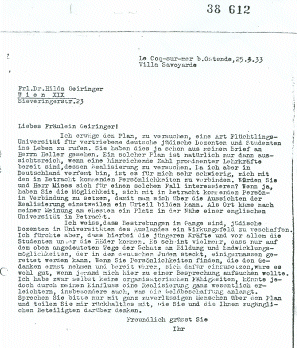
March 25, 1933, Einstein letter to Hilda Geiringer re a new university to relocate German Jewish
professors
I am formulating a plan to try to establish a university for refugees, i.e., exiled German Jewish docents and students. You have
already seen this idea in my letter to Mr. Heller. This plan would only work if sufficient numbers of prominent educators are willing
to try to make this idea a reality. Since I am estranged from Germany, it would be difficult for me to make contact with the
appropriate people. Would you and Herr [applied mathematician Richard von] Mises be interested in this proposition? If so, you have
the opportunity to make contact with the appropriate people so that a prognosis for this plan could be made.
Concerned about directly contacting Hilda Geiringer with this information since she was still in Nazi Germany, Einstein
sent this letter to the Vienna address of Dr. Ernst Geiringer, Hilda's brother. On May 2, 1933, using a commercial letterhead, he
replied to Einstein that the letter had arrived and that he had "carefully sent it to her . When I receive a reply from her, I will
take the responsibility of sending it on to you. I would appreciate it if you would send all subsequent correspondence also to this
address and not to Berlin."13
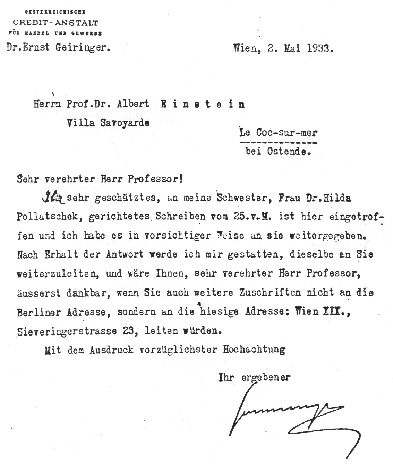 Ernst Geiringer's letter to Einstein, May 2 1933.
Ernst Geiringer's letter to Einstein, May 2 1933.
Einstein worked tiresessly to place Geiringer at an American university throughout the 1930s. There were many others. Including
renowned mathematician Oswald Weblen and astronmer Harlow Shapley as is evidenced by the next exhibit .
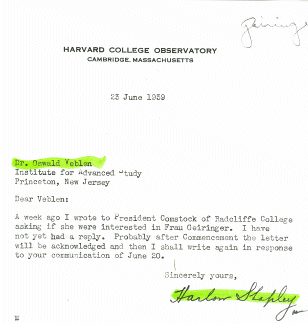
Harlow Shapley's response to an inquiery from Oswald Weblen dated June 20, 1939.14
Because of gender bias and antisemitism they did not succeed until 1939 at which time she was offered a lecturership at Bryn Mawr
– a women's college. Based on that, she was granted a visa. In the meantime she and her daughter Magda were saved by the Turkish
government's invitation.15 Moreover another letter dated August 5 1940
from St Andrews University speaks for itself:
Dear Mr. Einstein,
I am delighted in taking this opportunity to write you. I hope that after a long hiatus we can find a common bond between us. I
have been for one year at the old Scottish University of St. Andrews and I have erected a third observatory here.....
Now let's talk about the reason for this letter.
I was informed by a (female) friend16 at Harvard that Dr. Herbert Levy
and his wife (who are currently still in Berlin) that there is a certain hope, to rescue Dr. Levy out of the Hell of Berlin. And, if
I was informed correctly, your help was enlisted in supporting this distant relative of your former son-in-law.
I have promised my acquaintance to write to you and ask you as a personal favor to try everything possible to get Dr. Levy out of
Germany. I would be very thankful, if you could provide a few words to let me know, how far this endeavor has progressed.
I hope to receive good news in this matter from you.
Sincerely,
E. F. Freundlich17
A September 17, 1933 letter from Einstein to Turkish Prime Minister Ismet Inonu pleaded for Turkey to invite "fourty
experienced specialists and prominent scholars... to settle and pracitce in your country."
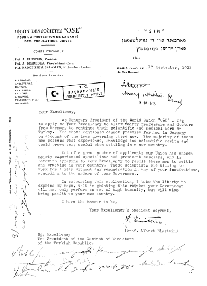
A recently discovered September 17, 1933 letter on the letterhead of OSE,
signed by Albert Einstein to Turkish Prime Minister Ismet Inonu 18
The hand-written Turkish annotations are compelling.19 The top
right notation shows that Inonu transferred the letter to the Maarif Vekaleti, Ministry for National Education on October 9,
1933. The other annotations are attributable to
Resit Galip, the sitting Minister. One says: "this proposal is incompatible with clauses [in the existing laws],"20 another: "[i]t is impossible to accept it due to prevailing conditions,"21 indicating that at the outset the proposal was rejected by the Ministry.
Nonetheless "Turkey invited more than 4022 German scientists and gave them
university posts. The University Reform conducted at this time makes us think that someone at higher rank, that is president Mustafa
Kemal [Ataturk], personally intervened in the matter."23 Ataturk was
determined to modernize Turkey.24.
Parenthetically it should be mentioned that Einstein left Belgium for England ten days before the letter was written,
and thus was not in Paris on that day. According to Einstein archivist Barbara Wolf "it is possible that during his stay in Paris in
summer of 1933 Einstein signed a number of blanc sheets with OSE letterhead. More probable (given the small space in which the
signature is placed) seems the hypothesis that a representative of OSE met Einstein and had him sign the letter. In any event,
Einstein signed it in his capacity of OSE's Honorary President, and it is not a personal letter."25
The fact that Schwarz's success preceded the Einstein plea is documented by the arrival of the first invitees in Istanbul on
October 25, 1933 as is noted below.
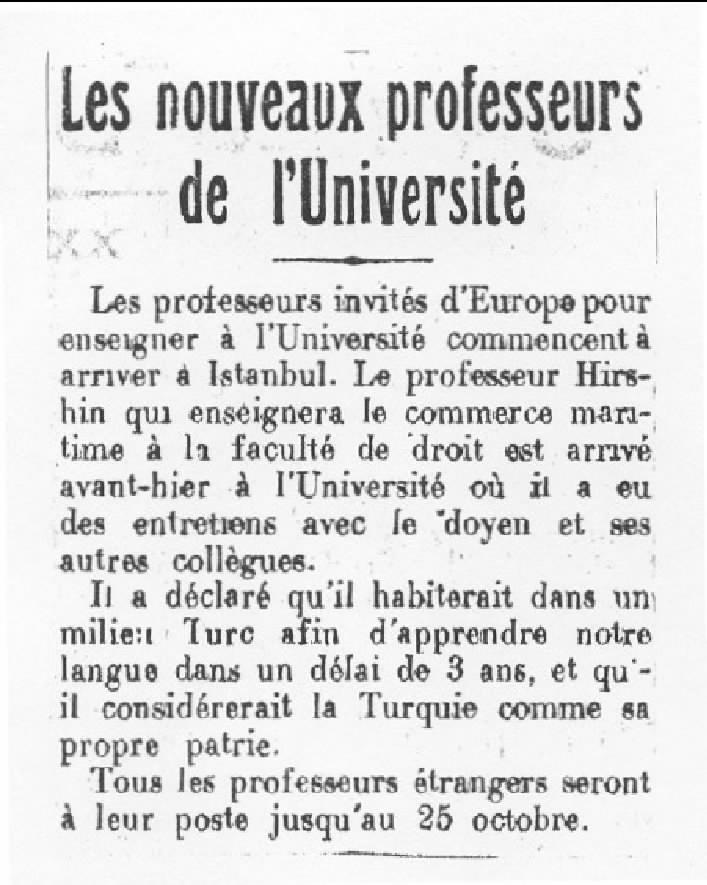
New Professors of the University
New professors invited from Europe to teach at the University have started to arrive in Istanbul. Professor Hirsch who will teach
Trade Law at the Law Faculty arrived the day before at the university where he had talks with the dean and his colleagues. He stated
that he will reside in a Turkish milieu in Istanbul so that he can learn Turkish within three years and that he considered Turkey as
his own country. All the foreign professors will be at their posts by 25th of October. Le Journal d'Orient October 20,
1933
A recently discovered response letter to Einstein reinforces the fact that Schwarz's success preceded the Einstein
plea.
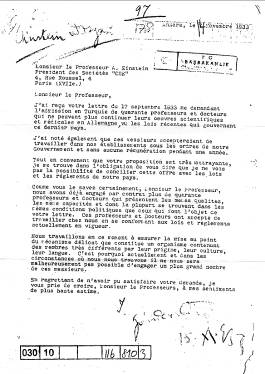
Ismet Inonu's letter of response to Einstein. November 14, 1933.26
The Inonu letter states:
Distinguished Professor,
I have received your letter dated 14 November 1933 requesting acceptance by Turkey of 40 professors and physicians who cannot
conduct their scientific and medical work in Germany anymore under the laws governing Germany now.
I have also taken note that these gentlemen will accept working without remuneration for a year in our establishments under our
government.
Although I accept that your proposal is very attractive, I have to tell you that I see no possibility of rendering it compatible
with the laws and regulations of our country.
Distinguished Professor, as you know, we have now more than 40 professors and physicians under contract in our employ. Most of
them find themselves under the same political conditions while having similar qualifications and capacities. These professors and
doctors have accepted to work here under the current laws and regulations in power.
At present, we are trying to found a very delicate organism with members of very different origins, culture and languages.
Therefore I regret to say that it would be impossible to employ more personnel from among these gentlemen under the current
conditions we find ourselves in.
Distinguished Professor, I express my distress for being unable to fulfill your request and request that you believe in my best
sentiments."
The 14 November 1933 Inonu letter was preceded by the following announcement.
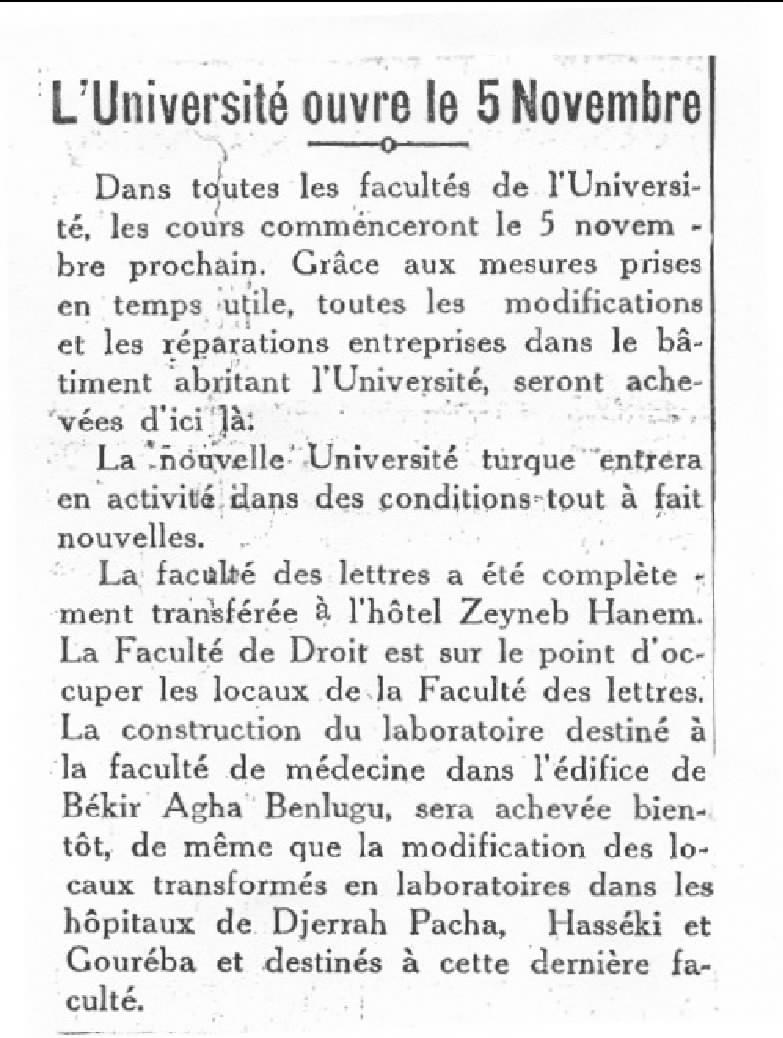
University Opens Fifth of November
Courses will start on November 5th in all faculties of the University thanks to all necessary measures being completed
in timely fashion. All alterations and repairs in the building housing the University will be completed between now and then.
The new Turkish University will start its activities under completely new conditions.
The Faculty of Letters has been entirely transferred to the Zeynep Hanim Konagi.
The Faculty of Law will soon occupy the locale of the Faculty of Letters.
The construction of the laboratory in the Bekir Aga Binasi intended for the use of the Faculty of Medicine will soon be
completed. The same is true for alterations of spaces transformed into laboratories in the Hospitals of
Cerrah Pasa, Haseki and Gureba for the same Faculty.
On the face of it Inönü's letter appears to have closed the doors to Einstein's plea. Fortunately matters did not end with the
position taken by Inönü when he wrote that letter. Before the end of hostilities in Europe Turkey, had saved not just 30 as
originally agreed to by Schwarz nor forty as indicated in the Inönü letter. Over 190 intellectuals had been
saved. Moreover they were saved initially from Germany, from Austria after
the 1938 Anschluss, and from Czechoslovakia after the 1939 Nazi invasion of Prague.28 Because of Turkey's influence at least one needed professional, dentistry professor Alfred Kantorowicz, was
liberated from a nine month incarceration in a concentration camp and allowed to proceed with his family to Istanbul.29
There is little doubt about the fact that Atatürk was personally involved with the emigre professors. Soon after the arrival of
the first party he was known to have hosted a reception/banquet for them in the Dolmabahçe Palace. When the Shah of Iran visited Turkey for the first time,31 Atatürk personally arranged for Alfred Kantorowicz to create a set of dentures
for him32 and for Ophtalmologist Joseph Igersheimer to give the Shah an eye
examination and prescribe new lenses.33
Even after the 190 or so intellectuals were in Turkey's safe haven Einstein continued to place some of them at American
universities of stature. On December 3, 1933, he wrote a letter to David L. Edsall, Dean of the Harvard Medical School.34
I take the liberty to write to you, because I feel strongly a need to do what I possibly can to relieve the misery of those in
Germany who are suffering despite being innocent . I am referring to Prof. Dr. Friedrich Dessauer, University of Frankfurt who has
made a name for himself in the field of experimental physics applied to Medicine.
The man is in prison on a trumped up charge, in reality because of his activity in the Center Party. I consider it our human
responsibility to do the utmost to save this esteemed individual. I think it would help the man's fate if the Hitler regime would
learn that people abroad were interested in this man. Of course there is no hope that he would be released soon or permitted to leave
the country but it would be a loud and human gesture on his behalf, if one could send some letter of interest from an American
university.
Einstein concluded his letter to Dean Edsall by asking him to write such a declaration for Dessauer. By design or
happenstance, Edsall misinterpreted the plea35 and responded by pointing out
that there were no positions open at Harvard at that time. Undaunted, Einstein replied "It seems that I have not properly expressed my intentions. I was not talking about a real invitation for Professor
Dessauer, just a pretended one. The idea is to show that there is an interest abroad for this person. The aim is to stop the legal
proceedings against him which were intiated on spurious grounds. It is known that these things often occur for political reasons."
Dessauer was saved by being included among the Turkish government's invitees.
The subject of Einstein and Harvard can fill another article. The short of it is that Harvard's
President (1933-1953) James Bryant Conant was predisposed to anti-semitism. And that Harvard University had a long standing policy
of discrimination against Jews in faculty appoinments.37 The fact that there
was no turning point in that practice until the end of WWII is well documented.38 It is also well established that during the years surrounding 1935, Harvard's student body and The Crimson, its
paper, were sympathetic to the events taking place in Nazi Germany.39
According to historian Stephen H. Norwood,40 Harvard University President
James Bryant Conant's insistence on treating Nazi academics as part of the "learned world, and his reluctance to offer faculty
positions to prominent Jewish refugee scholars, was shaped in part by his own anti-Semitic prejudices." In 1936, Harvard sent an
official representative to celebrations at the University of Heidelberg which, like all German universities at that time, had
expelled all its Jewish professors and changed its curriculum to reflect Nazi ideology. Harvard also cultivated friendly ties with
another Nazi German university in Gottingen.41 When the DuPont Corporation
sought President Conant's advice about hiring a German-Jewish scientist who had fled the Nazis, Conant recommended against offering
him a job because he was "very definitely of the Jewish type—very heavy." The scientist they rejected, Max Bergmann,
was described by the New York Times as "one of the leading organic chemists in the world."42 Much of this was known to Einstein.
Germany the way it used to be was [a cultural] oasis in the desert.
- Albert Einstein,43
So it came as a surprise to this author to learn that Harvard's that Albert Einstein received an honorary SD degree in
1935. Documentation from primary sources was difficult to find. However after an extensive search the actual certificate was found
buried in the Einstein archives at the Hebrew University of Jerusalem. The Einstein archives themselves contain no notes about
Harvard's 1935 commencement. There are no copies in the archives of newspaper articles of the day that reported this event. The
certificate itself has never before been digitized nor posted. According to Einstein official curator at the Hebrew University of
Jerusalem, Barbara Wolf, it was hidden in a file marked "Protzenecke" (Pretences) along with honoraria from
less well known institutions.44

Einstein's Honorary SD from Harvard Certificate
The archives do not contain any copy of the Harvard Crimson of June 20, 1935, which carried the banner headline
HONORARY DEGREES TO BE AWARDED THIS MORNING. The article specifically headlined "ALBERT EINSTEIN" as one of the recipients45 The Harvard Alumni Bulletin of July 5, 1935 reinforced the above with:
In 1935 Albert Einstein received a new honorary doctorate, this time by the most traditional and most important university of the
USA, the Harvard University in Cambridge, Massachusetts. It was Thursday, June 20, 1935 when he was awarded the Doctor of Science in
a ceremony. The president of the university, J.B. Conant, said in a speech about Einstein: "…Acclaimed by the world as a
great revolutionist of theoretical physics, his bold speculations, now become basis doctrine, will be remembered when mankind`s
present troubles are long forgotten…"(emphasis added)46
Nowhere in the archives is there a copy of the June 1935 Commencement Program. Yet Harvard's websites continue to use that event
as a promotional tool. According to Ms Wolf, Einstein did not have any of his honorary degrees hanging on his walls except for one.
That was from the Bernese Naturforschende Gesellschaft.47 Ms
Wolf suggested that it was there so that Einstein could tell his secretary and others "of the deceitfulness of the people who issued
honorific certificates."48 Albert
Einstein's honorary degree certificate from America's most prestigious university had been tucked away, never displayed. Perhaps it
was too painful a reminder of President Conant's duplicitous, self serving behavior that occurred later in 1936. Parenthetically it
may be noted that the 70th anniversary of the ceremony at which Albert Einstein was awarded Harvard's honorary SD, came and went in
2005 without much fanfare or acknowledgement. Einstein's willingness to be used by Harvard in 1935 is still something of a mystery.
However a year later when Harvard celebrated its 300th anniversary. Einstein was again invited to particpate in gala
ceremonies. At first Einstein accepted, then he backed out.
Why then would Einstein who knew of Harvard's biased hiring practices had suspicions of President Conant's anti-Semitic attitudes
accept an honorary degree from him?49 Possibly because "The essence of
Einstein's political practice seems to have been a form of political participation in exerting moral influence on people
and organizations through public declarations and appeals."50 Einstein
may have been a bit naive, hoping that "perhaps" he could have some influence and affect a change at Harvard. If Harvard changed,
then the other universities would follow. Einstein continued working in that regard for years thereafter. Imagine, then, the
disappointment, disillusionment, and hurt, when Harvard's hiring practices remained unchanged until after the war and after the
monumental changes in America's higher education an undisputable result of its GI Bill of Rights.
Epilogue
The conduct of the German intellectuals – seen as a group – was no better than that of the mob.51
1
Arnold Reisman received his PhD in engineering from UCLA and is a retired professor of operations research from Case Western Reserve
University. As an independent scholar he authored Turkey's Modernization: Refugees from Nazism and Atatürk's Vision. Washington,
DC: New Academia Publishers, 2006. In addition:
SHOAH: Turkey, The US and the UK (Charleston, SC: BookSurge Publishing. 2009)
Refugees and reform: Turkey's republican journey (Charleston, SC: BookSurge Publishing. 2009)
Ambassador and a Mentsch: The story of a Turkish Diplomat in Vichy France
(Due out June 2010)
2
http://www.thewjc.org/sermons/einstein.htm Viewed September 3, 2007, 3
In a personal communcation dated September 5, 2007, Ms. Barbara Wolf, Curator, Albert Einstein Archives, Hebrew University
of Jerusalem, wrote: "Although I cannot pretend having read (all) 600 books written about Einstein, at least I dare to claim that I
read the most reliable biographies & monographies (reliable: based on authentic, original material) published in German,
English and French, except those which are dealing exclusively with AE's scientific research and theories. I do not
remember having found any mention of Einstein's efforts to place Jewish intellectuals in Turkey circa 1933."
Moreover, Marcia Tucker, Curator of the Archives of the Institute for Advanced Study had a similar response to a similar
question. Personal communcation dated September 5, 2007. Similar response was also received from professor Tuvia Friling, The
Ben-Gurion Research Institute, Ben-Gurion University of the Negev, Israel, a noted historian of that period and of that part of the
world, eg. Turkey and the Balkans. 4
"Einstein worked feverishly to rescue kin, friends, kin of friends and even strangers from the maw of Hitler's Germany. He
personally vouched for dozens, establishing in their names as many $2,000 bank accounts (required by immigration authorities) as he
could afford. When tapped out, he beseeched friends and colleagues to put up funds, guaranteeing the deposits himself."
http://www.momentmag.com/Exclusive/2007/2007-04/200704-Einstein.html Viewed September 2,
2007
5
ORT-OSE Dinner, in London, October 29, 1930, Albert Einstein Archives, Hebrew University of Jerusalem, Document 29
034 - 1
6
Neumark noted that three revolutions came together to make the 1933 "miracle" happen in Turkey: Russian in 1905, Turkish in
1923 and Nazi in 1933. F. Neumark, Zuflucht am Bosporus: Deutsche Gelehrte, Politiker und Künstler in der Emigration 1933-
1953 (Escape to Bosporus: German scholars, politicians, and artists in exile 1933-1953) (Frankfurt: Knecht, 1995),
13. 7
Philip Schwartz, organizer of the Notgemeinschaft lost his sister and her entire family in Germany's gas chambers.
P. Schwartz , Notgemeinschaft Zur Emigration deutscher Wissenschaftlernach 1933 in die Turkei. (Marburg: Metropolis-Verlag,
1995) organizer of the Notgemeinschaft lost his sister and her entire family in Germany's gas chambers. 8
For details see L. A. Burk, "An Open Door: German Refugee Professors in Turkey" in The Dispossesed-An Anatomy
of Exile, ed. Peter I. Rose (Amherst, MA: University of Massachusetts Press, 2005), 235-257
9
H. Müller, "German Librarians in Exile in Turkey, 1933-1945." Libraries & Culture, 33.3, (1998): 294-
305. 10
Ibid 11
L. Fermi, Illustrious Immigrants. (Chicago: University of Chicago Press, 1968), 67.
12
See A. Reisman, "What a Freshly Discovered Einstein Letter Says About Turkey Today" HNN, http://hnn.us/articles/31946.html. For a clearer image of the letter see
http://armenians-1915.blogspot.com/2006/11/1243-what-freshly-discovered-einstein.html.
Posted November 27, 2006. 13
Albert Einstein Archives Princeton University, Document No. 53 610
14
Oswald Veblen Papers, Container 31. Manuscripts Division, Library of Congress. 15
Reisman, A. (2007) "Hilda Geiringer: A Pioneer of Applied Mathematics and a Woman Ahead of Her Time Was Saved from Fascism
by Turkey" Forthcoming in Women in Judaism: A Multidisciplinary Journal on August 28. Available
at http://ssrn.com/abstract=994590
16
Martha B. Shapley, wife of Harvard astronomer Harlow Shapley. The couple will be discussed later.
17
In Albert Einstein's own words that astronomer E. Finlay Freundlich ""was the first among fellow-
scientists who has taken pains to put the [relativity] theory to the test." Obituary in The Times
<http://www.aam314.vzz.net/Freundlich.html> Viewed September 30 2005.
18
There is some discrepancy as to who originally found this letter in the Foreign Ministry archives. For a discussion of that see,
Reisman, A. (2006) What a Freshly Discovered Einstein Letter Says About Turkey Today, History News Network, 11-20-06,
http://hnn.us/articles/31946.html
19
This letter has been circulating within Turkey via the web for some time prior to its publication by the Hürriyet.
This author received at least five e-mails from Turkish friends with the letter attached starting early October 2006. 20
"Teklifin mevzuat? kanuniyeyle telifi mümkün de?ildir." 21
"Bunlar? bugünkü ºeriata göre
kabule imkan yoktur." 22
The first group of invitees in 1933 numbered 30. It later grew to over 190 intellectuals and with families and staff the
totaled over 1000 of saved individuals. For a complete listing of the individual intellectuals see Reisman, Turkey's
Modernization: Refugees from Nazism and Atatürk's Vision. (Washington DC: New Academia Publishers, 2006) pp 474-478 23
According to Istanbul University's historian of science Prof. Feza Günergün (Cumhuriyet, Science and Technology
Supplement, Nov. 3, 2006, Year: 20, Number: 10240) Einstein's letter of September 17, 1933 was preceded by the July 6, 1933
agreement between the Turkish government and the "Notgemeinschaft" organization, (to be discussed later) at which time contracts
for 30 German scientists had already been issued. Günergün suggested that by his letter "perhaps encouraged by this
agreement Einstein made an attempt to send another 40 to Turkey."
24
Reisman, A. (2006) What a Freshly Discovered Einstein Letter Says About Turkey Today, History News Network, 11-20-
06, http://hnn.us/articles/31946.html 25
The author thanks Ms Barbara Wolff of the Einstein Archives at the Hebrew University of Jerusalem for her learned and
helpful advice on this matter. Personal communication.
26
Rifat Bali, a Turkish historian discovered this document in the Turkish State Archives during November 2006.
27
See A. Reisman, Turkey's Modernization 190. Some of the Emigres served as conduits of communication between colleagues,
friends, and relatives left behind and others in the free world. It is a great fortune from a historical perspective that some of
this correspondence was preserved for posterity. See Reisman, Arnold, German Jewish Intellectuals' Diaspora in Turkey: (1933-1955).
The Historian Vol. 69 no. 3 pages 450-478, Fall.
28
Ibid 200 29
Ibid 166 30
<http://vonhippel.mrs.org/vonhippel/life/AvHMemoirs9.pdf> Viewed on October 7, 2005. 31
A. Reisman, Turkey's Modernization 190 32
Ibid 165,166, and 260 33
Ibid 156, 157 34
Courtesy Albert Einstein Archives, Hebrew University of Jerusalem, Document 49 476-1 and 2. 35
At the time Harvard University had very strong ties with Nazified Germasn universities under the leadership of its president
James Bryant Conant. Reisman, TURKEY'S MODERNIZATION: Refugees from Nazism and Atatürk's Vision. p. 515, 516. Also, A.
Reisman, "Harvard University's Tercentenary celebrations and Albert Einstein: 1936." Working Paper (2007). 36
Courtesy Albert Einstein Archives, Hebrew University of Jerusalem, Document 49 477. 37
For an extensive documentation of both issues see A. Reisman, Turkey's Modernization: Refugees from Nazism and
Atatürk's Vision. (Washington, DC: New Academia Publishers. 2006) 38
A. Reisman, Turkey's Modernization: Refugees from Nazism and Atatürk's Vision (Washington, DC: New Academia
Publishers, 2006): 215-219, 312, 315, 330, 355, 503, . 39
Andrew Schlesinger, "The real story of Nazi's Harvard visit" The Boston Globe. November 18, 2004. http://www.boston.com/news/globe/editorial_opinion/oped/articles/2004/11/18/ the_real_story_of_nazis_harvard_visit/
Viewed November 17, 2006. Also, Stephen H. Norwood, "Harvard's Nazi Ties" October 26 2005. The David S. Wyman
Institute for Holocaust Studies. <http://www.wymaninstitute.org/articles/2004-11-harvard.php>. Viewed January 5
2006. 40
S.H. Norwood, "Legitimating Nazism: Harvard University and the Hitler Regime, 1933-1937" American Jewish
History : 92, 2, June 2004, pp. 189-223 41
<http://www.wymaninstitute.org/bostoncont.php>. Viewed on October 27 2005. 42
Max Bergmann, …..formerly director of the Kaiser-Wilhelm Institute for Leather Research, joined the Rockefeller
Institute in 1933; he was one of many German scientists of the intellectual migration. A protégé of Emil Fischer,
Bergmann had developed in Germany a leading center for protein chemistry, attracting students from around the world. His successful
career continued in his new homeland, which he considered "the best country on the globe" (Felix Haurowitz file,
July 8 1943). His research program, which focused on the action of proteolytic enzymes on synthetic peptides and on the problem of
protein structure, aimed at explaining the biological specificity of proteins. As determinants of specificity, proteins were then
generally regarded as the active hereditary material in the chromosomes; Bergmann's investigations were also intended to account for
this genetic specificity. The Bergmann Papers—letters, reports, addresses, and lectures— are therefore important not only
for the history of biochemistry, but also for the history of molecular genetics. The correspondence shows Bergmann to be a central
figure within the international network of protein chemists, and instrumental in helping other émigré biochemists in
the 1930s. (emphasis added) <http://www.amphilsoc.org/library/guides/kay/Primary.htm>. Viewed on October 27
2005. 43
Albert Einstein, July 1934, Letter to Alfred Kerr. Einstein Archive 50-687
44
Personal communication, November 21, 2006 45
http://www.thecrimson.com/article.aspx?ref=453819. Viewed on November 19, 2006 46
http://www.einstein-website.de/z_information/honours.html#harvard, Viewed on November 21, 2006 47
Personal communication, November 22, 2006 48
A note that Helen Dukas left. That note is part of her (informal & private) correspondence with Otto Nathan, a "jungle
of unordered papers." Personal communication, November 22, 2006
49
The June 20, 1935, Boston Evening Transcript carried a front page article titled "Einstein and Thomas Mann Hailed at
Harvard Exercises: Two German Exiles 'Steal' Commencement." Shown next to the article was a group photo with Einstein and Conant
center stage front row. 50
H. Goenner, "Albert Einstein and Friedrich Dessauer: Political Views and Political Practice" Physics in Perspective: 5,1 (2003) 21-66 51
Albert Einstein, January 28, 1949, Letter to Otto Hahn. Einstein Archive 12-072
~~~~~~~
from the June 2010 Edition of the Jewish Magazine
|
